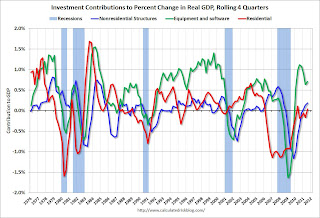by Calculated Risk on 10/27/2011 10:37:00 AM
Thursday, October 27, 2011
GDP slightly above pre-recession peak, Investment Contributions
According to the Bureau of Economic Analysis (BEA), real GDP is finally just above the pre-recession peak. The estimate for real GDP in Q3 (2005 dollars) was $13,352.8 billion, 0.2% above the $13,326.0 billion in Q4 2007. Nominal GDP was reported as $15,198.6 billion in Q3 2011.
The following graph is constructed as a percent of the previous peak. This shows when GDP has bottomed - and when GDP has returned to the level of the previous peak. If the indicator is at a new peak, the value is 100%.
At the worst point, real GDP was off 5.1% from the 2007 peak. Since the most common definition of a depression is a 10%+ decline in real GDP, the 2007 recession was not a depression. Note: There is no formal definition of a depression. Some people use other definitions such as the duration below the previous peak. By that definition, using both GDP and employment, this seems like the "Lesser depression", but not by the common definition.
 Click on graph for larger image.
Click on graph for larger image.
This graph is for real GDP through Q3 2011 and shows real GDP is back to the the pre-recession peak.
Note: There are really two measures of GDP: 1) real GDP, and 2) real Gross Domestic Income (GDI). The BEA will release GDI with the 2nd GDP estimate for Q3. GDI was back to the pre-recession peak in Q2.
The following graph shows the rolling 4 quarter contribution to GDP from residential investment, equipment and software, and nonresidential structures. This is important to follow because residential investment tends to lead the economy, equipment and software is generally coincident, and nonresidential structure investment trails the economy.
For the following graph, red is residential, green is equipment and software, and blue is investment in non-residential structures. The usual pattern - both into and out of recessions is - red, green, blue.
 Residential Investment (RI) made a positive contribution to GDP in Q3 2011, and the four quarter rolling average finally turned positive in Q3.
Residential Investment (RI) made a positive contribution to GDP in Q3 2011, and the four quarter rolling average finally turned positive in Q3.
Equipment and software investment has made a significant positive contribution to GDP for nine straight quarters (it is coincident).
The contribution from nonresidential investment in structures was positive in Q3. Nonresidential investment in structures typically lags the recovery, however investment in energy and power is masking weakness in office, mall and hotel investment (the underlying details will be released next week).
The key leading sector - residential investment - has lagged this recovery because of the huge overhang of existing inventory. Usually RI is a strong contributor to GDP growth and employment in the early stages of a recovery, but not this time - and this is a key reason why the recovery has been sluggish so far.
 Although Residential Investment (RI) increased slightly in Q3, RI as a percent of GDP declined slightly - and RI as a percent of GDP is at a new record low.
Although Residential Investment (RI) increased slightly in Q3, RI as a percent of GDP declined slightly - and RI as a percent of GDP is at a new record low.
I'll break down Residential Investment (RI) into components after the GDP details are released this coming week. Note: Residential investment (RI) includes new single family structures, multifamily structures, home improvement, broker's commissions, and a few minor categories.
As expected, RI is increasing slowly in 2011 and it looks like RI will add to both GDP and employment growth - for the first time since 2005. It won't be much, but it will probably be positive.
 The last graph shows non-residential investment in structures and equipment and software.
The last graph shows non-residential investment in structures and equipment and software.
Equipment and software investment has been increasing sharply, however several tech companies have lowered their outlooks - so investment in equipment and software might slow in Q4.
Non-residential investment in structures increased in Q3. I'll add details for investment in offices, malls and hotels next week.
Earlier ...
• Advance Estimate: Real Annualized GDP Grew at 2.5% in Q3


